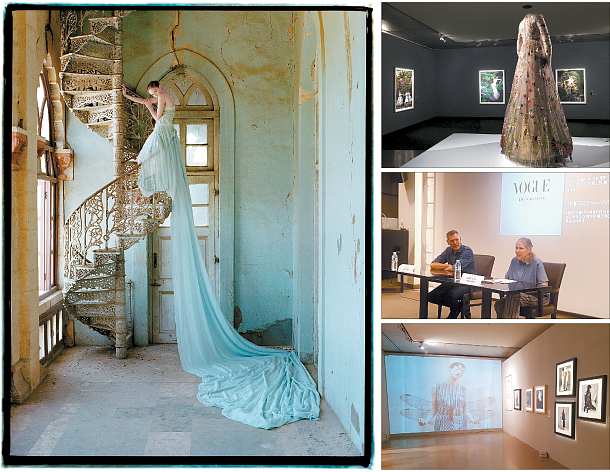Reflecting art history in fashion’s greatest photos : ‘Vogue Like a Painting’ shows fine art’s influence on editorial photography

Left: Lily Cole on Spiral Staircase, Whadwan, Gujarat, India, 2005, by Tim Walker. Right from top: Valentino by Maria Grazia Chiuri & Pierpaolo Piccioli inside the gallery. Debra Smith and Erwin Olaf at a press conference for the exhibition. The special Vogue Korea section of the exhibition. [VOGUE, MOON SO-YOUNG, YOON SO-YEON]
In the autumn of 2015, Vogue held its first photo exhibition at the Museo Thyssen-Bornemisza in Madrid, Spain which featured 60 fashion photographs inspired by famous paintings, hand-picked from the Vogue photo archive. This year, the exhibition has grown. The new projector director at Vogue Spain and curator of the exhibition, Debra Smith, added 41 more photos from the Vogue archive and 19 photos from Vogue Korea to add flavor to the gallery’s walls.
“Fashion is a difficult business. These days, fashion has become more of a business. Sometimes the artistic principles get easily replaced by commercial ones,” said Smith at the press conference on June 23.
While comparing a photographic work to that of a chef, Smith explained that this exhibition comes as “great ingredients,” such as the models, the makeup artists and photographers, were combined by the finest craftsmanship. “One of the aims is to slow people down. We’re going through our lives so fast, digesting images like fast food, like McDonalds,” added Smith.
The exhibition allows for a rare opportunity to witness the works of the 32 greatest photographers of our time, including Irving Penn, Paolo Roversi, Peter Lindbergh, Tim Walker, Nick Knight and Albert Watson. Taking after works from classic Dutch portraits to Monet’s impressionist landscapes and the postmodern abstract expressionism of Jackson Pollock, Vogue photographers have created a modern-day interpretation of historical artworks, capturing a timelessness that is simultaneously classic and modern.
The gallery is divided into five main sections - Portrait, Still Life, Rococo, Landscape and From the Avant-garde to Pop Art - with a separate special section featuring photos from Vogue Korea.
The portraits section welcomes visitors with a collection of photos influenced by famous portrait paintings across the ages. The photos pay homage to the history of portraiture, ending up with the fierce, yet elegant images of fashion models. Even without reading the provided explanations, visitors will be able to recognize the famous paintings of Johannes Vermeer, John Singer Sargent, Pisanello and Egon Schiele.
In the Still Life section of the gallery, visitors can see the delicate techniques of photographers that captured the lights, compositions and colors that the master craftsmen utilized in their paintings. Keeping the original on the objects like painters Vincent van Gogh, Jan Brueghel and Paul Cezanne, while at the same time putting a fashionable lens on the non-living models, the photos flaunt the artistic eye of its creators that saw beauty in the symbols each objects carried in a world obsessed with superficiality.
The Rococo style is a common theme found in many fashion shoots, because of its obvious elegance and combination of gold and pastel colors. The photos take the visitors through time to the Palace of Versailles, the birthplace of the exquisite French form of art.
Photos in the landscape section show fewer direct references to the originals on display. While some photos show an apparent relation to famous pieces such as Nascita de Venere (birth of Venus) by Sandro Botticelli, others give off only a subtle resemblance to forefathers, such as Jean-Honore Fragonard.
The section titled “From the Avant-garde to Pop Art” features the dynamic art movements that took place in the 20th century. The Bauhaus movement, abstract expressionism, American modernism, postmodernism, Pop Art and cubism are just some of the styles explored by the photographers’ creativity to create unique shots.
Vogue Korea is a special section added by Smith, who explained her reason for choosing Seoul as the second venue for the exhibition was because, “People [in Korea] have an appetite for art and learning about art.”
A separate room of the gallery allows visitors to see the Korean uniqueness infused into images by Korea’s most talented photographers such as Koo Bohn-chang, and a modern interpretation of the Korean culture by Paolo Roversi.
BY YOON SO-YEON [yoon.soyeon@joongang.co.kr]
The exhibition is open from 11 a.m. to 8 p.m., and runs until Oct. 7. Entrance is 13,000 won ($11.35) for adults, 11,000 won for teenagers and 9,000 won for children. To go to the Seoul Arts Center, get off at Nambu Bus Terminal Station, line No. 3 exit 4-2 or 5. For more information, visit www.voguelike.com or call (02) 332-8011.










with the Korea JoongAng Daily
To write comments, please log in to one of the accounts.
Standards Board Policy (0/250자)